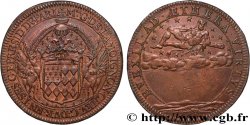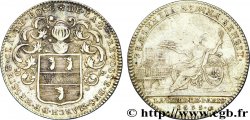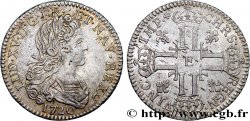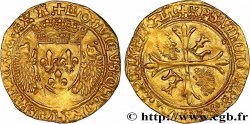E-auction 175-109411 - fjt_405012 - ILE DE FRANCE - TOWNS AND GENTRY Jeton de Mariage Aligre et Pontcarré 1818
Чтобы принять участие в торгах, вы должны войти в систему и стать подтвержденным участником аукциона. Войдите, чтобы сделать ставку. Ваш аккаунт будет подтвержден в течение 48 часов. Не ждите до закрытия торгов, чтобы зарегистрироваться.Сделав ставку на данный товар, вы вступаете в юридическое соглашение на покупку выбранного товара и нажатием кнопки «Сделать ставку» подтверждаете принятие вами условий интернет-аукционов cgb.fr.
Ставка может бить сделана только в полном эквиваленте евро. Торги закроются согласно времени, указанному в описании товара, все ставки, сделанные после закрытия торгов, учитываться не будут. Не следует откладывать предложение вашей ставки до последнего момента, так как система может не успеть обработать вашу заявку, и ваша ставка не будет принята. Более детальную информацию вы найдёте здесь: FAQ по интернет-аукционам.
БЕСПЛАТНО.
БЕСПЛАТНО.
| Оценить : | 85 € |
| Цена : | 32 € |
| Максимальная предлагаемая цена : | 54 € |
| Конец торгов : | 22 August 2016 18:57:30 |
| Участников : | 8 Участников |
Тип Jeton de Mariage Aligre et Pontcarré
Дата: 1818
Металл: silver
Диаметр: 34 mm
Ориентация осей монеты: 12 h.
Век: lisse
Пуансон: sans poinçon
Редкость: R2
Лицевая сторона
Аверс: легенда: PROBIS AMICIS PAUPERIBUS VITAM IMPENDERE.
Аверс: описание: Les armoiries des deux familles sur un dais couronné.
Обратная сторона
Реверс: легенда: ETIENNE J. F. C. D’ALIGRE . LOUISE C. A. C. PONTCARRE À L’EXERGUE EURE ET LOIR. 1818.
Реверс: Описание: Vue de face du bâtiment de l’hôpital d’Aligre à Bonneval en Eure et Loir.
Комментарий
Nos personnages sont de noblesse parisienne par les Aligre et de Bretagne par les Camus de Pontcarré.
On trouve à http://mapage.noos.fr/hubert.demory/pomereu.htm une histoire de la famille :
Etienne IV, marquis d'Aligre, fut maître des requêtes puis conseiller d'honneur au parlement de Paris ; son fils Etienne-Claude ( 1694-1752 ) fut président à mortier au parlement de Paris. ( Rappelons que le mortier était une espèce de bonnet, en forme de mortier renversé, réservé au chancelier - en drap d'or brodé d'hermine - aux présidents et au greffier en chef du parlement - en velours noir avec 1 ou 2 galons d'or.)
La descendance continue avec Etienne-François, marquis d'Aligre, comte de Marans, né le 17 juillet 1727 ; il fut président à mortier en 1752, vice chancelier début 1768 et le 25 septembre premier président du parlement et enfin commandeur des ordres du roi. Il constitua une fortune considérable. " Il avait, disait-on, cinq millions de capitaux dans la banque à Londres et disposait de 700 000 livres de revenu ; les présidents étant associés à toutes les affaires comportant des épices, il aurait touché, en dix-sept ans, des vacations représentant quatre cents années de travail." rapporte M. Provost dans le dictionnaire biographique de Roman et d'Amat. Il participa activement à la lutte entre les parlements et Louis XV en 1770 et reçut une lettre de cachet l'exilant dans sa terre de Tremblay. Il revint en 1774 lorsque Louis XVI rappela les parlements mais continua à lutter contre les réformes que l'on voulait imposer aux parlements, refusant notamment d'enregistrer les édits du timbre de subvention territoriale, finalement il démissionna en novembre 1788. A la Révolution, il s'installa avec toute sa famille à Londres mais mourut à Brunswick en 1798. C'est lui que la Ville de Paris a voulu honorer en donnant le nom d'Aligre à une rue et à une place attenante le 26 février 1867.
A sa mort, son fils, Etienne-Jean-François-Charles, né à Paris en 1770, rentra à Paris. Il fut nommé par Napoléon, en 1803, conseiller général de la Seine et Louis XVIII en fit un pair de France. En 1791, il épousa Marie-Adélaïde Godefroy de Senneville qui décéda en 1793 après lui avoir donné une fille : Etiennette laquelle épousera Michel de Pomereu, marquis de Ryceis, ainsi que nous l'avons vu. Etienne d'Aligre, dont les deux frères étaient chanoines, obtint, le 21 décembre 1825, une ordonnance décidant que le nom d'Aligre serait transmis au fils aîné de ce mariage. Quant à lui, il épousa sa cousine germaine, Louise-Charlotte-Aglaé Camus de Pontcarré qui possédait, comme lui, une fortune considérable qu'ils utilisèrent pour faire le bien autour d'eux. On leur doit la création de l'asile d'Aligre à Chartres, l'hôpital d'Aligre à Bonneval en Eure-et-Loire et la station thermale de Bourbon-Lancy en Saône-et-Loire.
.
Our characters are of Parisian nobility through the Aligre and of Brittany through the Camus de Pontcarré.
It can be found at http://mapage. noos. fr/hubert. demory/pomereu. htm a family history: Etienne IV, Marquis d'Aligre, was master of requests then honorary councilor at the parliament of Paris; his son Etienne-Claude (1694-1752) was president of the parliament of Paris. (Let us remember that the mortarboard was a kind of cap, in the shape of an inverted mortarboard, reserved for the chancellor - in gold cloth embroidered with ermine - for the presidents and the chief clerk of parliament - in black velvet with 1 or 2 gold braids. ) The line continues with Etienne-François, Marquis d'Aligre, Count of Marans, born on July 17, 1727; he was president of the mortar in 1752, vice chancellor at the beginning of 1768 and on September 25, first president of the parliament and finally commander of the king's orders.. He built up a considerable fortune. \\\"He was said to have five million in capital in the bank in London and to have 700,000 pounds of income; the presidents being associated with all business involving spices, he would have received, in seventeen years, vacations representing four hundred years of work. \\\" reports M. Provost in the biographical dictionary of Roman and Amat. He actively participated in the struggle between the parliaments and Louis XV in 1770 and received a lettre de cachet exiling him to his land of Tremblay. He returned in 1774 when Louis XVI recalled the parliaments but continued to fight against the reforms that were to be imposed on the parliaments, notably refusing to register the edicts of the territorial subsidy stamp, finally he resigned in November 1788. During the Revolution, he moved with his whole family to London but died in Brunswick in 1798.. It was him that the City of Paris wanted to honor by giving the name Aligre to a street and an adjoining square on February 26, 1867..
Upon his death, his son, Etienne-Jean-François-Charles, born in Paris in 1770, returned to Paris. He was appointed by Napoleon in 1803 as general councilor of the Seine and Louis XVIII made him a peer of France.. In 1791, he married Marie-Adélaïde Godefroy de Senneville who died in 1793 after giving him a daughter: Etiennette who would marry Michel de Pomereu, Marquis de Ryceis, as we have seen.. Etienne d'Aligre, whose two brothers were canons, obtained, on December 21, 1825, an order deciding that the name d'Aligre would be passed on to the eldest son of this marriage.. As for him, he married his first cousin, Louise-Charlotte-Aglaé Camus de Pontcarré who, like him, possessed a considerable fortune which they used to do good around them.. We owe them the creation of the Aligre asylum in Chartres, the Aligre hospital in Bonneval in Eure-et-Loire and the spa resort of Bourbon-Lancy in Saône-et-Loire..
On trouve à http://mapage.noos.fr/hubert.demory/pomereu.htm une histoire de la famille :
Etienne IV, marquis d'Aligre, fut maître des requêtes puis conseiller d'honneur au parlement de Paris ; son fils Etienne-Claude ( 1694-1752 ) fut président à mortier au parlement de Paris. ( Rappelons que le mortier était une espèce de bonnet, en forme de mortier renversé, réservé au chancelier - en drap d'or brodé d'hermine - aux présidents et au greffier en chef du parlement - en velours noir avec 1 ou 2 galons d'or.)
La descendance continue avec Etienne-François, marquis d'Aligre, comte de Marans, né le 17 juillet 1727 ; il fut président à mortier en 1752, vice chancelier début 1768 et le 25 septembre premier président du parlement et enfin commandeur des ordres du roi. Il constitua une fortune considérable. " Il avait, disait-on, cinq millions de capitaux dans la banque à Londres et disposait de 700 000 livres de revenu ; les présidents étant associés à toutes les affaires comportant des épices, il aurait touché, en dix-sept ans, des vacations représentant quatre cents années de travail." rapporte M. Provost dans le dictionnaire biographique de Roman et d'Amat. Il participa activement à la lutte entre les parlements et Louis XV en 1770 et reçut une lettre de cachet l'exilant dans sa terre de Tremblay. Il revint en 1774 lorsque Louis XVI rappela les parlements mais continua à lutter contre les réformes que l'on voulait imposer aux parlements, refusant notamment d'enregistrer les édits du timbre de subvention territoriale, finalement il démissionna en novembre 1788. A la Révolution, il s'installa avec toute sa famille à Londres mais mourut à Brunswick en 1798. C'est lui que la Ville de Paris a voulu honorer en donnant le nom d'Aligre à une rue et à une place attenante le 26 février 1867.
A sa mort, son fils, Etienne-Jean-François-Charles, né à Paris en 1770, rentra à Paris. Il fut nommé par Napoléon, en 1803, conseiller général de la Seine et Louis XVIII en fit un pair de France. En 1791, il épousa Marie-Adélaïde Godefroy de Senneville qui décéda en 1793 après lui avoir donné une fille : Etiennette laquelle épousera Michel de Pomereu, marquis de Ryceis, ainsi que nous l'avons vu. Etienne d'Aligre, dont les deux frères étaient chanoines, obtint, le 21 décembre 1825, une ordonnance décidant que le nom d'Aligre serait transmis au fils aîné de ce mariage. Quant à lui, il épousa sa cousine germaine, Louise-Charlotte-Aglaé Camus de Pontcarré qui possédait, comme lui, une fortune considérable qu'ils utilisèrent pour faire le bien autour d'eux. On leur doit la création de l'asile d'Aligre à Chartres, l'hôpital d'Aligre à Bonneval en Eure-et-Loire et la station thermale de Bourbon-Lancy en Saône-et-Loire.
.
Our characters are of Parisian nobility through the Aligre and of Brittany through the Camus de Pontcarré.
It can be found at http://mapage. noos. fr/hubert. demory/pomereu. htm a family history: Etienne IV, Marquis d'Aligre, was master of requests then honorary councilor at the parliament of Paris; his son Etienne-Claude (1694-1752) was president of the parliament of Paris. (Let us remember that the mortarboard was a kind of cap, in the shape of an inverted mortarboard, reserved for the chancellor - in gold cloth embroidered with ermine - for the presidents and the chief clerk of parliament - in black velvet with 1 or 2 gold braids. ) The line continues with Etienne-François, Marquis d'Aligre, Count of Marans, born on July 17, 1727; he was president of the mortar in 1752, vice chancellor at the beginning of 1768 and on September 25, first president of the parliament and finally commander of the king's orders.. He built up a considerable fortune. \\\"He was said to have five million in capital in the bank in London and to have 700,000 pounds of income; the presidents being associated with all business involving spices, he would have received, in seventeen years, vacations representing four hundred years of work. \\\" reports M. Provost in the biographical dictionary of Roman and Amat. He actively participated in the struggle between the parliaments and Louis XV in 1770 and received a lettre de cachet exiling him to his land of Tremblay. He returned in 1774 when Louis XVI recalled the parliaments but continued to fight against the reforms that were to be imposed on the parliaments, notably refusing to register the edicts of the territorial subsidy stamp, finally he resigned in November 1788. During the Revolution, he moved with his whole family to London but died in Brunswick in 1798.. It was him that the City of Paris wanted to honor by giving the name Aligre to a street and an adjoining square on February 26, 1867..
Upon his death, his son, Etienne-Jean-François-Charles, born in Paris in 1770, returned to Paris. He was appointed by Napoleon in 1803 as general councilor of the Seine and Louis XVIII made him a peer of France.. In 1791, he married Marie-Adélaïde Godefroy de Senneville who died in 1793 after giving him a daughter: Etiennette who would marry Michel de Pomereu, Marquis de Ryceis, as we have seen.. Etienne d'Aligre, whose two brothers were canons, obtained, on December 21, 1825, an order deciding that the name d'Aligre would be passed on to the eldest son of this marriage.. As for him, he married his first cousin, Louise-Charlotte-Aglaé Camus de Pontcarré who, like him, possessed a considerable fortune which they used to do good around them.. We owe them the creation of the Aligre asylum in Chartres, the Aligre hospital in Bonneval in Eure-et-Loire and the spa resort of Bourbon-Lancy in Saône-et-Loire..








 Cообщить об ошибке
Cообщить об ошибке Распечатать страницу
Распечатать страницу Отправить мой выбор
Отправить мой выбор Задать вопрос
Задать вопрос Consign / sell
Consign / sell
 Информация
Информация















